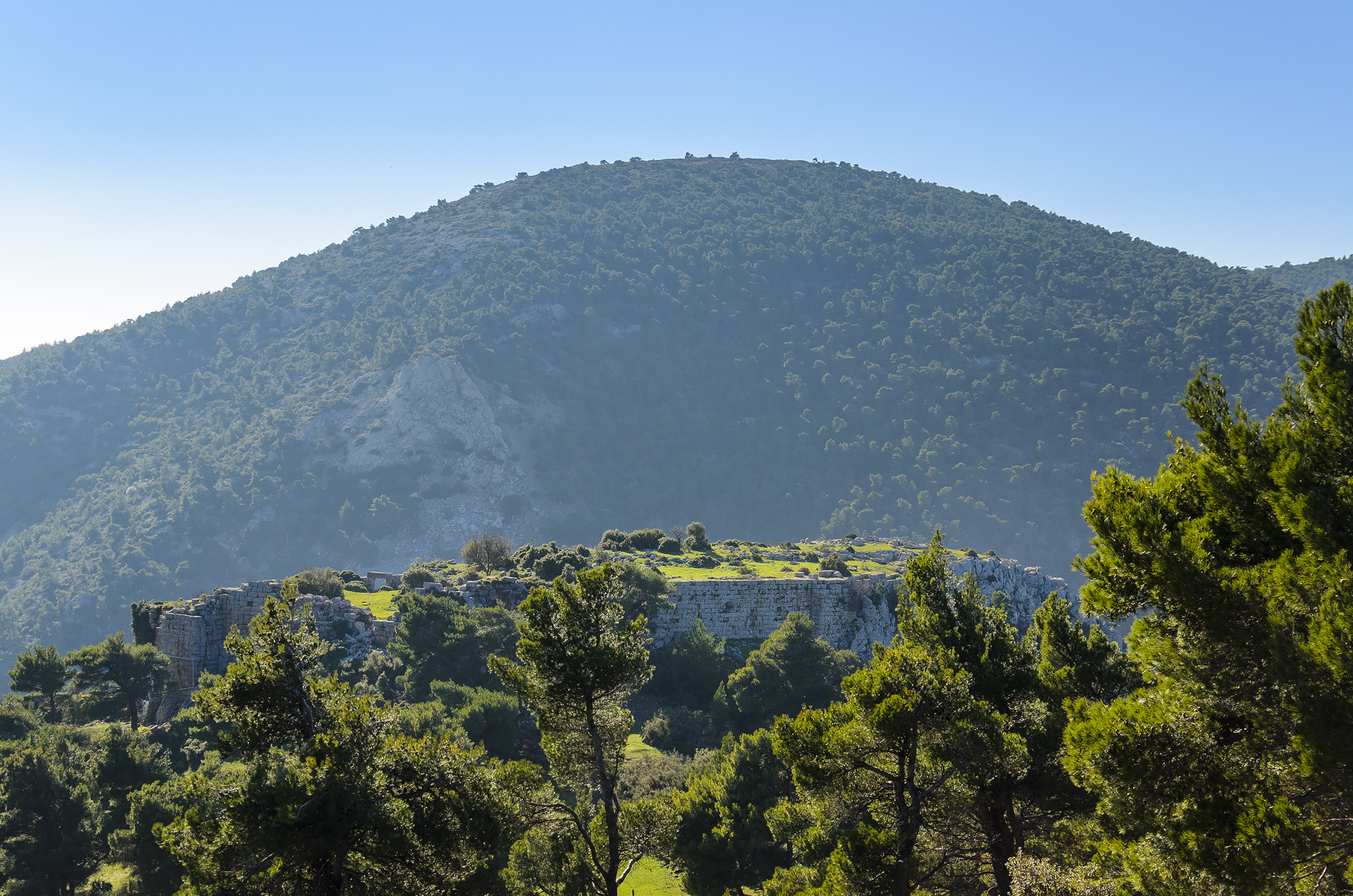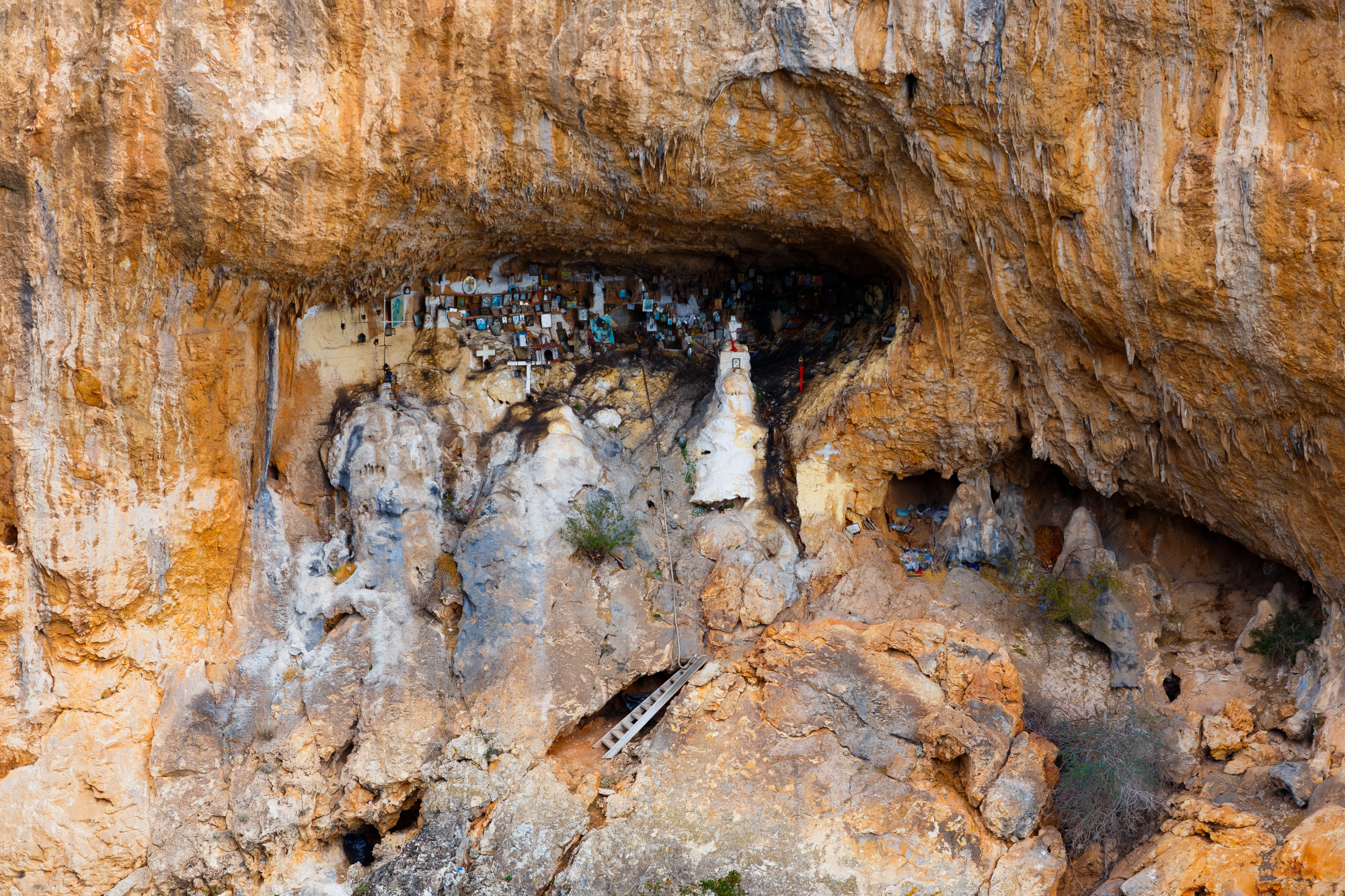On the west of Parnitha, the Dervenochoria villages have an unknown and exciting history, interesting monuments, mainly monasteries and fortresses, and very good food with excellent meats.
To reach the plateau the villages are located on, at an altitude of about 500 m you’ll go through lovely forests with streams and rivers, bridges and springs, the very old, historic Kliston monastery and the ancient fortress of Fyli. And all that at just 45 km from the centre of Athens.
Kliston Monastery
As you leave Fyli behind, in the direction of the Dervenochoria, the city already appears to be far far away, as the trees surround you and you get lost in nature. Make a detour, following the sign to the Kliston monastery.
The first building of the compound you’ll see is a modern one. It’s not clear when the monastery was built exactly, but there are signs, like the one on the narthex, dated 1204, suggesting that the original monastery of the Kimisis tis Theotokou Kliston Fylis may have been first established in the 11th century, with subsequent expansions made to it. The monastery is built in a wild, imposing landscape on the western, rocky, bank of the gorge of river Keladonas’ (Gouras). The gorge’s banks fade in the horizon but the rumble of the (unseen) river of the Giannoula gorge reach the monastery at 600 m height.
The “Arma” (Kaliakouda) rocks, the mountaintops “Tamilithi” and “Alogopetra”, the mountain ranges “Thodora” and “Kalliniko” that surround the monastery add to the landscape’s harshness and power. Drive on the main road for 3 km, and then turn right and drive until you get to the dreamy clearing of Agia Paraskevi, where you’ll find a spring, a small theatre and picnic tables and benches. Drive a bit further away on the wide forest road, until you reach a sign prohibiting access, as well as a boom barrier. If you walk for another 500 m, you’ll reach a small waterfall, where you’ll have quiet, trees and the bubbling waters.
The fortress of Fyli
Return to the main road and very soon you’ll get to the fortress of Fyli, the most famous of the many fortresses on Parnitha. It was built by the Athenians after the defeat of the Persians – with whom the Thebans had sided aiming to take charge of the road that linked Athens to Thebes, in the 4th century B.C. If you stand there, overlooking the area from 850 m height, you’ll understand why the location was chosen for this fortress-observation tower-phryctoria. Nothing could cross the roads below without the guards noticing.
Today, only some of the foundations and a few taller walls remain from the fortress, that was built using large grey boulders. The wall is more than 2,5 m thick and the rocks on the west side are so steep and inaccessible that no walls were built there. It is said that Pisistratus’ opponents set forth from here in the 6th century B.C. to kill the tyrant, and that this is the castle that Thrasybulus conquered in 403 B.C. during his expedition against the Thirty Tyrants that the Spartans had imposed to Athens, after they lost the Peloponnesian War. The location remained in the hands of Demetrius the Besieger until 283 B.C.. Since then, the fortress of Fyli stopped having a major role in events.
As you stand at the fortress, you’ll have an unobstructed view of Athens – the Athens of Pisistratus, Thrasybulus, Demetrius, the Romans, and today’s concrete Athens. You’ll be able to see the Acropolis and the Egaleo tower, while on the north side you’ll have a view of the Skourta valley, it’s truly a magnificent view.
At Dervenochoria
Get back on the main road in the direction of the Dervenochoria villages, and in particular of the two larger ones, Pyli and Skourta. If you’re interested in unknown (and gorgeous) local landmarks, before you reach Pyli, turn right to Dafni and then towards the ghost village Dafnoula. A dirt road will lead you to the bridge of Asopos. In the green valley, a lovely lone stone bridge crosses over the battered, historic river. About 6 m tall, with one vault and two small arches, it’s a real surprise seeing something like this in Attica and not in the Zagarochoria area.
The word Derveni derives from the Turkish (derven) and means narrow passage between mountains, closure. You have already passed the northern border of Attica, the majestic mount Parnitha and you’ve reached Boeotia. The five Dervenochoria villages, Pyli, Skourta, Stefani, Panaktos, and Prasino, together with Dafni and Dafnoula stretch out on a beautiful plateau at 500-600 m altitude.
The villages were isolated for many years, even in the beginnings of the 21st century it felt as if they were going back in time instead of going forwards. The Sunday bazar with products by local producers, as well as by producers from other nearby areas, add to the place’s interest, despite the traffic jam it causes for a few years.
There are countless paths around that will lead you to amazing fir-covered areas – after all this place is at the edge of the Parnitha national park – as well as forest roads for you to enjoy nature while you drive. There are ravines and gorges, and steep cliffs and caves. An unexplored world offering adventure to Athenians at just 45 km from the city centre through Fyli, while it’s just 25 km from Elefsina and Shimatari.
In general, there are many things to see in the Dervenochoria villages – historic monuments, churches and monasteries of great interest, while the area has a long history. A history we are reminded of by the statue of chieftain and member of the Filiki Eteria (Society of Friends – a crucial organization during the Greek War of Independence in 1821) Athanasios Skourtiotis (whose real name was Gatsis), made by sculptor G. Megkoulas, as well as by the stories about captain Stefa (Stefanos) Maliatsis of ELAS (Greek People’s Liberation Army), who during the battle of Pyli in 15-16 October 1943, gave the order to open fire even though the Germans were holding his son as a human shield.
But the main reason to come here is the famous local meat taverns, some of which have modernised their looks, while most still preserve the aesthetic of a typical Greek grill-tavern. What’s certain is that they all still preserve their gastronomic tradition in meat dishes, interspersed by Arvanite dishes like tzolia and tiganopsomo (fried bread) with cheese.
The taverns
The tavern “Aris” (Pyli, tel. 0030 2263031209, 0030 6944512711) first welcomed guests 100 years ago, and, apart from necessary repairs, remains the same since then.
Giorgos Georgas, the third generation in charge, together with his sisters and his mother, Eleni, in the kitchen, keeps the tradition alive. Order first the tiganopsomo with cheese, the handmade tzatziki, the fries and seasonal salads. For your main course, you can choose between roast lamb, lamb and goat chops, mutton, pork sausages they make themselves, mildly seasoned beef, pork steaks, kokoretsi (traditional dish with intestines wrapped around offal), lamb pluck with oil and oregano sauce, and chicken patties. The lamb is local, as is the sourdough bread, sourced from “Stamatis” bakery (tel. 0030 2263031338) where they use their own flour, growing their own wheat and other grains. Finally, for dessert they offer pancakes with honey, as well as yogurt with honey – the yogurt, as well as the feta is from the dairy “Liggos”. Make sure you call in advance.
After 35 years, Giannis Kollias decided to refresh the family tavern “Stelios Kollias” (Pyli, tel. 0030 2263031064, 0030 694 444 2572) that Stelios and Irini Kollia first opened in 1987. It’s the first tavern, right before you enter the village, on the left (the other road leads to Thebes). It’s only open on weekends, so it’s best to reserve a table. He painted the walls in modern, soft shades, installed a fireplace, and continues to prepare and offer, together with his wife, Katerina, and their two children, traditional dishes. Start your meal with “Katerina’s salad” that consists of many different vegetables, pomegranate and walnuts, then order the tiganopsomo that their 16-year-old daughter prepares, a recipe by grandma-Irini. Continue with handmade tzolia with dry mizithra cheese and burnt olive oil, and then order the meat: kokoretsi and kontosouvli (large pork skewers over open fire) that they marinade themselves, suckling pig, and skewered lamb, lamb chops, and, around Easter also goat chops, grilled mutton, beef sausages from a local producer, pork and beef steaks, and chicken. They bake their sourdough bread over open fire. Greens grown or wild, collected from the mountain when in season, tzatziki and homemade tirokafteri (spicy feta spread). They bring the cheeses from Agios Thomas and serve local bulk wine. For dessert, they’ll serve yogurt with honey, halva, and saraglaki (rolled baklava), or a fruit platter with apple and orange with orange zest, honey, walnuts and cinnamon.
Kostas Kalbenis first opened “O Kotsoulis” (Skourta, tel. 0030 2263031324, 0030 6946058108) in 1986, and now his son, Tasos, has the reigns. They have a very large hall with a fireplace – where they also host receptions and other events. In the kitchen, his mother and his wife, prepare the casserole dishes, and he prepares the grilled meats. Start with the typical local dishes, like tiganopsomo, the local feta and local wine, wild greens, and maybe a lamb pluck with oregano olive oil. Then choose from the roast lamb and goat, the grilled mutton, as well as pork or lamb kontosouvli. In the winter they also make goat stew. Their wood-burning oven is an added bonus, where they place Dutch ovens with goat and potatoes, mutton with tomato and onions, suckling pig, as well as pans with anything you order, like stew for example. The dessert menu includes loukoumades (traditional fried dough balls) with honey, yogurt with honey, and often they also make ravani (traditional semolina cake with syrup). They open at noon on the weekends, as well as on many weekdays.
Read also:
Exploring Mount Penteli – Davelis cave, waterfalls, trekking routes
Unique mountaineering experience: Conquering the highest mountain in Greece
Hiking and biking on Hymettus, a mountain for the whole family








